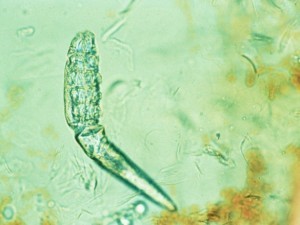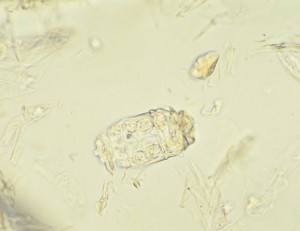In certain situations, dips may be recommended for treatment of skin conditions in dogs and cats. Use of dips has become less common, but they should not be forgotten! Factors such as age of pet, disease condition being treated, health status of the pet, the number of animals that will require treatment, cost of overall therapy, availability and safety of FDA approved products for the condition, etc. affect treatment decisions.

Amitraz Dips
Amitraz (Mitaban®) is an FDA approved dip product that may be used for the treatment of dogs with generalized demodecosis (red mange, demodex). Mitaban® is FDA-approved for demodex at certain concentrations and frequencies. Whole body clipping in long haired dogs is required throughout treatment so the dip can reach the mite where it resides in the hair follicle. Dips are usually preceded by a medicated shampoo.
The Mitaban® dip solution is packaged in individual dosing vials of concentrate that is diluted in water to a specific concentration just prior to application. Side effects of Mitaban® can be encountered, especially in small dogs. Side effects may include sedation (most common), decrease in body temperature, blood pressure fluctuations, loss of appetite, vomiting, or diarrhea. We recommend application in a veterinary hospital under supervision so that the dog may be monitored on the day of application.
Humans may also experience side effects if they contact this agent. It should not be handled by or applied around individuals on certain medications such as MAOI inhibitors or blood pressure medications. Absorption may also cause transient elevations in blood glucose, so individuals with diabetes should not apply or handle this agent. It can be an airway irritant, so we do not recommend application by any asthmatic human or on any dog with airway disease.
One advantage of amitraz is that there are antidotes for the drug if side effects are experienced by the dog (yohimbine and antipamezole). If a dog experiences side effects, an antidote is given and the dip is immediately washed off the patient. Mitaban® dips are usually applied either weekly or every two weeks according to the veterinarian’s prescription. This dip cannot be washed off between applications, so pets should not be permitted to swim, come in contact with heavy rain or be bathed between applications. Occasionally, another form of amitraz (Taktic®) is chosen because of the periodic lack of availability of Mitaban® (but it is not an approved formulation). Different dilution instructions are required for Taktic®. Use of amitraz dips for the treatment of demodex has become less widely used, but veterinary dermatologists will consider all risk factors when making treatment decisions.

Lime Sulfur Dips
Lime sulfur is another agent used as a topical dip in dogs and cats. It is most often used for the treatments of surface dwelling parasites and dermatophytosis (ringworm). Lime sulfur solution must be diluted in water before application. The treatment protocol varies depending on what is being treated, but most often, the diluted dip is applied once weekly for six weeks, and for two dips beyond cure of the condition. It may be deactivated in direct sunlight. It will stain clothing and harm some jewelry or stain porous surfaces. It will cause a yellow tinge to the hair coat of the animal while being treated. It has an odor that is strong when wet and diminishes when dry. In general, lime sulfur is safe in puppies and kittens, but consult a veterinarian and obtain a prescription after examination by a veterinarian prior to any application. Lime sulfur dips are a good consideration in animals for which other disease conditions contraindicate other available medications.
Lime sulfur dips are the only effective treatment for Demodex gatoi, a surface dwelling contagious demodex mite that affects only cats. Cats usually otherwise healthy and present with severe pruritus (itch) and may have alopecia, erythema, scale, crusts, and hyperpigmentation. Affected sites include the head, neck, limbs, ventrum, and flanks. Often, a new kitten or cat is introduced into a multi-cat situation and itch develops in several cats. The newly introduced cat does not always itch. Diagnosis is made by superficial skin scrapings, hair trichograms, and/or fecal floatation. The presence of only a few mites may result in clinical signs, and mites are difficult to recover. A “response to treatment” is another method of diagnosis. The current recommendation for treatment is 2% lime sulfur dips weekly for six weeks and reevaluate. All cats in the household or in contact with an affected cat should be evaluated for the presence of mites, as some may be asymptomatic carriers and be the source of the mite infestation for the household. It is recommended that all cats in a household be treated when D. gatoi is confirmed or suspected.
Lime sulfur dips are a component of the treatment plan for dermatophytosis (ringworm) in cats. This fungal infection caused by Microsporum canis in cats is a nuisance, contagious and zoonotic. It is diagnosed based upon examination of lesions, cytology, hair trichograms, fungal culture, and wood’s lamp examination. Fungal culture is needed for definitive diagnosis. When identified in a multi-cat environment, all cats should be evaluated and cultured. The veterinarian will recommend a “toothbrush culture” of non-lesional cats to determine if they are carriers of dermatophytes spores (picked up from the environment).
Successful treatment involves systemic therapy, topical therapy and environmental cleanup. The most important component of treatment is topical therapy. Use of lime sulfur dip reduces immediate and ongoing environmental contamination. Lime sulfur dip is cost effective, easy to apply, and safe in kittens and pregnant animals. Lime sulfur dips are applied one to two times a week until two consecutive negative cultures are confirmed and then two additional dips are applied. Systemic therapy is also continued for two weeks after the second negative fungal culture is confirmed.
Related Reading:

